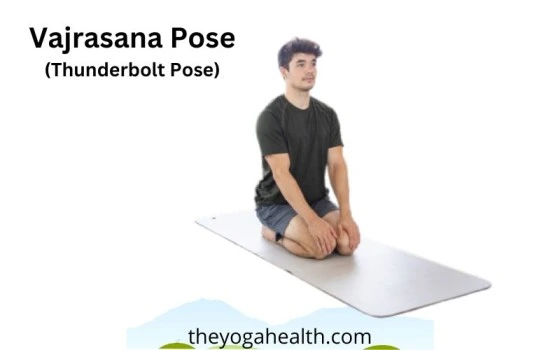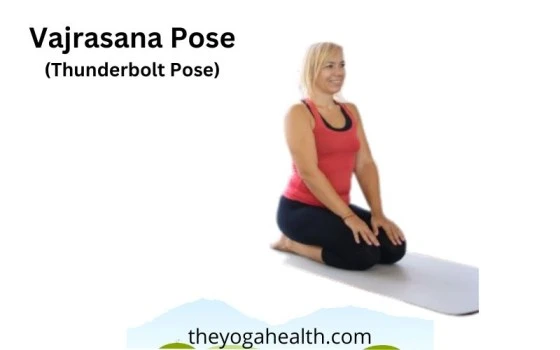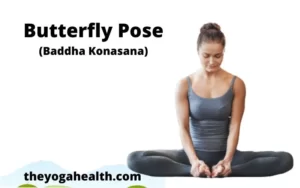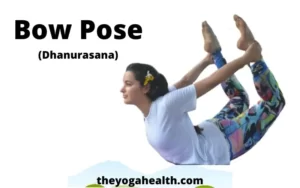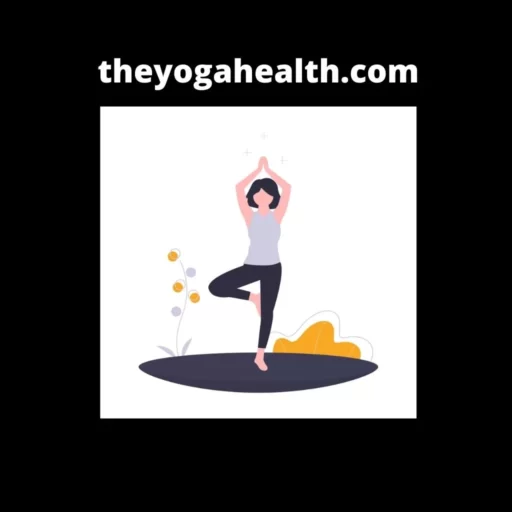If you are looking for a simple yet effective way to improve your health then Vajrasana pose, also known as Thunderbolt Pose, can be helpful. In this article we will explore in detail the effectiveness, meaning, steps, benefits, precautions etc of the Vajrasana.
Table of Contents
What is Vajrasana Pose?
Vajrasana Pose, also known as Thunderbolt Pose or Diamond Pose, is a popular yoga posture that has been practiced for centuries. This pose involves sitting on the heels while keeping your spine straight and hands resting on the knees.
This simple pose is often used for the purpose of pranayama and meditation. This is one such yoga pose which you can do even after having your meals.
Basic Details:
| Sanskrit Name | Vajrasana |
| English Name | Thunderbolt Pose |
| Difficulty Level | Beginner |
| Position | Sitting |
Health Benefits of Vajrasana Pose
Improved Digestion:
Practicing this asana after meals can aid digestion by stimulating the digestive organs. It helps in relieving problem of gas and bloating. It also reduce acidity in the body and promote a healthy digestive system.
Strengthened Back Muscles:
Sitting in this pose helps in the proper alignment of the spine and in improving the posture.
Reduced Stress and Anxiety:
This asana has a relaxing effect on the nervous system which makes it an excellent pose for reducing stress and anxiety levels.
Enhanced Blood Circulation:
Sitting in this pose improves the blood flow levels in the pelvic areas and legs, which can be beneficial for those people having blood circulation issues.
Better Flexibility:
Consistent practice of Vajrasana can improve the flexibility of the knees, ankles, and thighs.
How to Do Vajrasana Pose
Find a Quiet Place:
Choose a quiet and peaceful spot where you can practice without any disturbances.
Kneel on the Floor:
Sit on your knees, keeping them together. Your big toes should touch, and your heels should be slightly apart.
Straighten Your Back:
Now straighten your spine erect and relax your shoulders. Place your hands on your knees and palms facing downwards.
Focus on Breathing:
Take a very slow and deep breaths while inhaling and exhaling.
Hold the Pose:
Stay in this position for 5 to 10 minutes, gradually increasing the duration as you get comfortable.
Release the Pose:
To come out of Vajrasana, slowly lift your hips and return to a comfortable sitting position.
Precautions and Tips
- Avoid Vajrasana if you have knee or ankle injuries. If you feel discomfort during the pose, release immediately. To avoid issues of discomfort or bloating practice this asana on an empty stomach.
- If you are new to the world of yoga then sitting in this pose for a long period may be challenging for you. You can initially start to sit in this pose for few minutes and later on as you get comfortable with the pose you can increase its time.
The Science Behind Vajrasana
Research papers on yoga and Vajrasana have shown interesting findings regarding its effects on the body and mind. A study published in the Journal of Clinical and Diagnostic Research supporting the traditional claim of this pose, which always emphasised that Vajrasana can increase blood flow in the pelvic area and improve digestion.
Another research paper in the International Journal of Yoga suggested that practice of Vajrasana can reduce stress levels and also improve emotional health, because this pose have a very positive impact on the autonomic nervous system.
Incorporating Vajrasana into Your Routine
Here are few tips for you to incorporate Vajrasana in your daily routine.
Warm-up:
Do a proper warm up of your body with gentle stretches and movements to prepare your knees and ankles for this pose.
Time It Right:
The right time to practice Vajrasana is morning or evening preferably on an empty stomach.
Consistency is the Key:
Just like all other Yoga Poses, regularity is important to take full benefits of Vajrasana. Aim to practice it regularly, even if it’s for a short duration.
Combine with Meditation:
Enhance the calming effects of Vajrasana by following it with a short meditation session. Just focus on your breathing and forgetting about any tension in your body or in your mind.
Listen to Your Body:
Although Vaujrasans is having many benefits still it is not suitable for everyone. Pay attention to your body and modify the pose as needed to avoid any discomfort.
Vajrasana Pose Variations
Once you feel comfortable with the basic Vajrasana, you can explore different variations to add variety to your practice:
Supta Vajrasana (Reclining Thunderbolt Pose):
This variation involves reclining backward from the seated position, stretching the abdomen and thighs.
Ardha Vajrasana (Half Thunderbolt Pose):
In this variation, only one leg is bent, while the other remains straight, providing a milder stretch to the knees and ankles.
Parvatasana (Mountain Pose in Vajrasana):
This variation combines Vajrasana with a gentle forward bend, promoting flexibility in the spine.
Addressing Common Myths About Vajrasana
As with any popular practice, there might be some misconceptions surrounding Vajrasana. Let’s debunk a few common myths:
Myth 1: Vajrasana is only for experienced yogis.
Fact: Vajrasana is a beginner-friendly pose that can be practiced by people of all levels. With proper guidance and modifications, even beginners can benefit from this pose.
Myth 2: Vajrasana is only for meditation.
Fact: While Vajrasana is indeed commonly used for meditation, it offers various health benefits beyond just calming the mind. It can be practiced independently or as part of a yoga sequence.
Myth 3: Vajrasana can cure all ailments.
Fact: While Vajrasana has numerous health benefits, it is not a cure-all solution. It should be seen as a complementary practice alongside a healthy lifestyle and medical treatments if necessary.
Myth 4: Vajrasana is all about forcing the body into a pose.
Fact: Vajrasana should never cause pain or discomfort. Listen to your body and make necessary adjustments to ensure a safe and enjoyable practice.
Preparing Yourself Mentally for Vajrasana
Apart from the physical readiness, preparing yourself mentally is also important for this pose. Here are some tips to prepare yourself mentally:
Set an Intention:
Before starting the pose, set a positive intention for your practice. It could be as simple as dedicating a few moments to yourself or cultivating inner peace.
Focus on Breath:
Concentrate on your breath during the practice. This will help in staying present and grounding yourself in the moment.
Embrace Patience:
Like any new practice, Vajrasana might take time to master. Do not rush yourself into the pose be patient and celebrate every small progress.
Some Experiences with Vajrasana
Let’s hear from some people who have incorporated Vajrasana into their lives:
Sarah, a working professional, shares: “After a long day at work, practicing Vajrasana helps me unwind and release tension from my back. It has become my go-to pose for relaxation.”
John, a fitness enthusiast, says: “I used to suffer from digestive issues, but ever since I started doing Vajrasana after meals, I’ve noticed a significant improvement in my digestion.”
Dimple, a marketing professional, says: “As a beginner, because I was having a pain in my knees so I was hesitant to try Vajrasana. But encouraged by my yoga instructor I incorporated this pose in my daily yoga routine and after few days I noticed a significant reduction in my knee discomfort. I feel more relaxed and focused these days during my meditation practice.”
Taking Vajrasana Beyond the Mat
Vajrasana doesn’t have to be limited to your yoga mat. You can incorporate the principles of this pose into your daily life:
Mindful Eating:
Adopt the Vajrasana pose while eating to promote mindful eating habits and aid digestion.
Stress Management:
When you encounter stressful situations, take a moment to sit in a modified Vajrasana posture to calm your mind and reduce anxiety.
Seeking Expert Guidance
While this article provides an excellent starting point, seeking expert guidance from a qualified yoga instructor is highly recommended. They can provide personalized instructions and ensure you practice Vajrasana safely.
Conclusion:
Vajrasana Pose (Thunderbolt Pose) is a time-tested yoga pose with a myriad of physical, mental, and emotional benefits. Vajrasana is a simple yet powerful yoga pose with numerous health benefits. From improved digestion to reduced stress, regular practice can positively impact your overall health.
If you will start slowly and listen to your body, it will always be beneficial. So why wait? Roll out your yoga mat and experience the magic of Vajrasana today!
FAQs: Vajrasana Pose
Q1. What are the benefits of practicing Vajrasana?
A: There are many benefits of practicing this Pose. It can improve your digestion, reduce stress levels, and strengthen the muscles of the back. The regular practice of this yoga pose can also improve blood circulation in the body.
Q2. Can beginners practice Vajrasana?
A: Yes, Vajrasana is beginner-friendly, and with proper guidance, anyone can practice it.
Q3. How long should I hold the Vajrasana pose?
A: You can start with 5 to 10 minutes in the beginning and gradually you can increase the time duration, when you get comfortable with the pose.
Q4. Is Vajrasana helpful for knee pain?
A: Some people find relief from knee pain with regular Vajrasana practice, but consult a professional if you have concerns.
Q5. Can Vajrasana cure all health issues?
A: Vajrasana offers various health benefits, but it is not a cure-all solution and should complement a healthy lifestyle.
Q6. Can I practice Vajrasana after meals?
A: Yes, practicing Vajrasana after meals can aid digestion, but do it on an empty stomach for maximum comfort.
Q7. How often should I practice Vajrasana?
A: This is a very easy yoga pose and can be practiced by most of the people in normal situations. You must practice Vajrasana regularly, even for a few minutes daily, to experience its full benefits.
Q8. Can Vajrasana improve flexibility?
A: Yes, Vajrasana can enhance flexibility in the knees, ankles, and thighs over time.
Q9. Can Vajrasana help with back pain?
A: Regular practice of Vajrasana can strengthen back muscles and potentially reduce back pain.
Q10. Is Vajrasana suitable for older adults?
A: Vajrasana can be suitable for older adults, but they should practice it at their comfort level and with caution.
Q11. Does Vajrasana improve posture?
A: Yes, Vajrasana helps in aligning the spine, which can lead to improved posture with consistent practice.
Q12. Can I combine Vajrasana with other yoga poses?
A: Yes, Vajrasana can be combined with other poses to create a well-rounded yoga practice.
Do share your experience of doing Vajrasana Pose (Thunderbolt Pose) and if You have any question or comments regarding this Pose, you can mention so in the comments section below.



